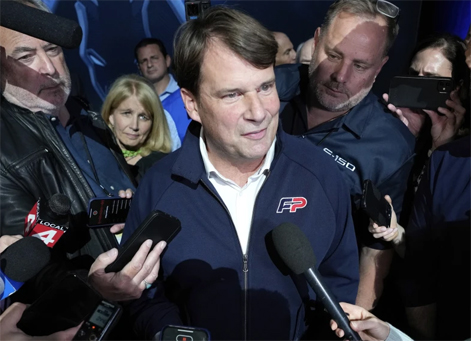|
|
|
|
|
|
 |
|
|
"File -
Jim
Farley,
President
and
Chief
Executive
Officer,
Ford
Motor
Company
speaks
to
reporters
about
the UAW
contract
talks at
the
North
American
International
Auto
Show in
Detroit,
Wednesday,
Sept.
13,
2023.
United
Auto
Workers
President
Shawn
Fain's
focus on
CEO pay
is part
of a
growing
trend as
emboldened
labor
unions
cite the
widening
wealth
gap
between
workers
and the
top
bosses
to
bolster
their
demand
for
higher
wages
and
better
working
conditions.
(AP
Photo/Paul
Sancya,
File)" |
| |
UAW
justifies
wage
demands
by
pointing
to CEO
pay
raises.
So how
high
were
they?
ALEXANDRA
OLSON
apnews.com
NEW
YORK -
It’s
been a
central
argument
for the
United
Auto
Workers
union:
If
Detroit’s
three
automakers
raised
CEO pay
by 40%
over the
past
four
years,
workers
should
get
similar
raises.
UAW
President
Shawn
Fain has
repeatedly
cited
the
figure,
contrasting
it with
the 6%
pay
raises
autoworkers
have
received
since
their
last
contract
in 2019.
He
opened
negotiations
with a
demand
for a
similar
40% wage
increase
over
four
years,
along
with the
return
of
pensions
and cost
of
living
increases.
The UAW
has
since
lowered
its
demand
to a 36%
wage
increase
but the
two
sides
remain
far
apart in
contract
talks,
triggering
a
strike.
Fain’s
focus on
CEO pay
is part
of a
growing
trend of
emboldened
labor
unions
citing
the
wealth
gap
between
workers
and the
top
bosses
to
bolster
demand
for
better
pay and
working
conditions.
In June,
Netflix
shareholders
rejected
executive
pay
packages
in a
nonbinding
vote,
just
days
after
the
Writers
Guild of
America
wrote
letters
urging
investors
to vote
against
the pay
proposals,
saying
it would
be
inappropriate
amid
Hollywood’s
ongoing
strike
by
writers.
The WGA
wrote
similar
letters
targeting
the
executive
pay at
Comcast
and
NBCUniversal.
Fain
has
pushed
back
against
arguments
that a
big pay
bump for
the
union
would
jack up
costs of
vehicles
and put
the Big
Three
automakers
—
General
Motors,
Ford and
Stellantis
(formerly
Chrysler)
— at a
disadvantage
against
foreign
competitors
with
lower-cost
workforces
in the
race to
transition
to
electric
vehicles.
“The
reason
we ask
for 40%
pay
increases
is
because
in the
last
four
years
alone,
the CEO
pay went
up 40%.
They’re
already
millionaires,”
Fain
told
CBS’
“Face
the
Nation”
on
Sunday.
“Our
demands
are
just.
We’re
asking
for our
fair
share in
this
economy
and the
fruits
of our
labor.”
CEO
pay has
ballooned
for
decades,
while
wages
for
ordinary
workers
have
lagged.
But did
the Big
Three
chief
executives
really
get 40%
pay
increases?
Not
exactly.
“I
don’t
know
where
the 40%
came
from,”
said
General
Motors
CEO Mary
Barra at
a new
conference
when
asked if
the
UAW’s
numbers
were
accurate.
Executive
pay is
notoriously
complicated
to
calculate
because
so much
of it
comes in
the form
of stock
grants
or stock
options.
A
detailed
look at
the
compensation
packages
at all
three
companies
shows
how the
UAW’s
claim
both
overstates
and
understates
reality,
depending
on the
view.
THE BIG
THREE
CEO PAY
PACKAGES
Barra,
the only
one of
the
three
who held
the role
since
2019, is
the
highest
paid,
with a
compensation
package
of worth
$28.98
million
in 2022.
The
single
biggest
component
was
$14.62
million
in stock
grants,
which
vest
over
three
years
and
whose
ultimate
value
depends
on stock
performance
and
other
metrics.
Her
pay has
increased
34%
since
2019,
according
data
from
public
filings
analyzed
for AP
by
Equilar.
Ford
CEO
James
Farley
received
nearly
$21
million
in total
compensation
in 2022,
a 21%
increase
over the
$17.4
million
then-CEO
Jim
Hackett
received
in 2019,
according
to the
company’s
proxy
statements.
Farley’s
package
last
year
included
$15.14
million
in stock
awards,
which
also
vest
over
three
years
with an
ultimate
value
dependent
on
performance.
Where
the the
comparison
gets
complicated
is at
Stellantis,
which
was
formed
in 2021
with the
merger
of
Italian-American
conglomerate
Fiat
Chrysler
Automobiles
and
French
PSA
Group.
Because
it is a
European
company,
the way
Stellantis
discloses
executive
pay
differs
significantly
from GM
and
Ford.
In
its
annual
renumeration
report,
Stellantis
reported
CEO
Carlos
Tavares’
2022 pay
was
23.46
million
euros.
That’s a
nearly
77%
increase
over
then
Fiat
Chrysler
CEO Mike
Manley’s
2019 pay
of 13.28
million
euros.
Those
are the
numbers
used by
the UAW
when it
calculated
that
three
automakers
have,
collectively,
increased
CEO pay
by 40.1%
since
2019,
according
to the
methodology
the
union
provided
to The
AP.
But
there’s
a catch:
Stellantis’
figures
reflect
“realized
pay,”
which
include
the
value of
previously
granted
equity
that
vested
during
the
reporting
year.
U.S.
companies,
in
contrast,
use
grant
date
value of
stock
packages
awarded
to
executives
during
the
reporting
year.
In
its
analysis,
Equilar
used the
“grant
date”
method
to make
an
equivalent
comparison
between
all
three
CEOs. By
that
measure,
Tavares’
2022
compensation
was in
21.95
million
euros in
2022,
including
10.9
million
in stock
awards
with a
three-year
vesting
period.
That’s
actually
24%
decline
from
Manley’s
compensation
package
in 2019,
which
was
29.04
million
euros,
according
to
Equilar.
THE
VOLATILITY
OF CEO
PAY
So,
is
Tavares
really
making
less
than
Manley
was four
years
ago? Not
really.
That’s
because
in some
years,
talking
about a
CEO’s
“realized
pay” can
obscure
exorbitant
pay
packages
approved
by
company
boards.
Take
Tavares’
2021
compensation
package,
which
included
special
incentive
award of
25
million
euros in
cash as
well as
stock
worth
19.56
million
euros —
all
contingent
on
long-term
performance
goals —
granted
to
Tavares
in
recognition
of “his
essential
role” in
leading
the
company
through
the
merger.
That
one-time
award,
which
came on
top of
millions
of more
in
regular
compensation,
alone
pushed
Tavares’
2021
compensation
package
far
above
what
Manley
got in
2019.
Stellantis
shareholders
voted
52.1% to
reject
the pay
proposal
in their
annual
meeting,
though
the vote
was only
advisory
and the
board
approved
his
package
anyway.
The
CEOs of
GM and
Ford
also saw
their
compensation
packages
peak in
2021,
before
declining
slightly
in 2022.
HOW DOES
ALL THIS
COMPARE
TO
REGULAR
WORKER
PAY?
However
you
slice
the
numbers,
the gap
between
CEO pay
and
rank-and-file
workers
at all
three
companies
is
gigantic.
At
GM, the
median
worker
pay was
$80,034
in 2022.
It would
take
that
worker
362
years to
make
Barra’s
annual
compensation.
At
Ford,
where
the
median
pay was
$74,
691, it
would
take 281
years.
At
Stellantis,
with a
median
pay of
64,328
euros,
it would
take 365
years,
although
the
company
noted
its
annual
report
that the
disparity
includes
expenses
related
to
Tavares’
one-time
grant.
Excluding
that,
the pay
ratio is
298-1.
How
extreme
that
disparity?
It
depends
on the
comparison.
It’s
far
above
the
typical
pay gap
at S&P
500
companies,
which
was
186-1
according
to AP’s
annual
CEO pay
survey,
which
uses
data
analyzed
by
Equilar.
And
it’s
astronomical
by
historical
standards.
According
to a
study of
the 350
largest
publicly
traded
U.S.
firms by
the
left-leaning
Economic
Policy
Institute,
the
CEO-to-Worker
pay
ratio
was just
15-1 in
1965.
The
automakers,
for
their
part,
emphasize
that
their
foreign
competitors
pay
their
workers
much
less.
Including
benefits,
workers
at the
Detroit
3
automakers
receive
around
$60 an
hour,
according
to Harry
Katz, a
labor
professor
at
Cornell
University.
At
foreign-based
automakers
with
U.S.
factories,
the
compensation
is about
$40 to
$45.
Then
there’s
Tesla.
CEO
Elon
Musk’s
2022
compensation
was
reported
as zero
in the
company’s
proxy
statement,
rendering
its
official
pay
ratio
meaningless.
Of
course,
that’s
because
Tesla
hasn’t
awarded
Musk new
packages
since a
2018
long-term
compensation
plan
that
could
potentially
be worth
more
than $50
billion
and is
facing a
legal
challenge
from
shareholders.
But
the
proxy
offers
glimpse
at the
mind-boggling
wealth
disparity
between
its
nonunion
workers
and one
of the
world’s
richest
men.
The
filing
reported
Musk’s
total
“realized
compensation”
in 2021
at more
than
$737
million.
A
typical
Tesla
worker
earned
$40,723
that
year.
According
to the
proxy,
for that
worker
to make
Musk’s
“realized
compensation”
that
year, it
would
take
more
than
18,000
years.
______
This
story
has been
corrected
to
reflect
Ford’s
CEO and
his
compensation
in 2019.
The CEO
was Jim
Hackett,
not
William
Clay
Ford,
and his
compensation
was
$17.4
million,
not
$16.76
million.
______
AP
Auto
Writer
Tom
Krisher
in
Detroit
contributed
to this
story.
Advertise With Us:

Certified Minority Business Enterprise

|
|
|
|
|
|
|
|
|